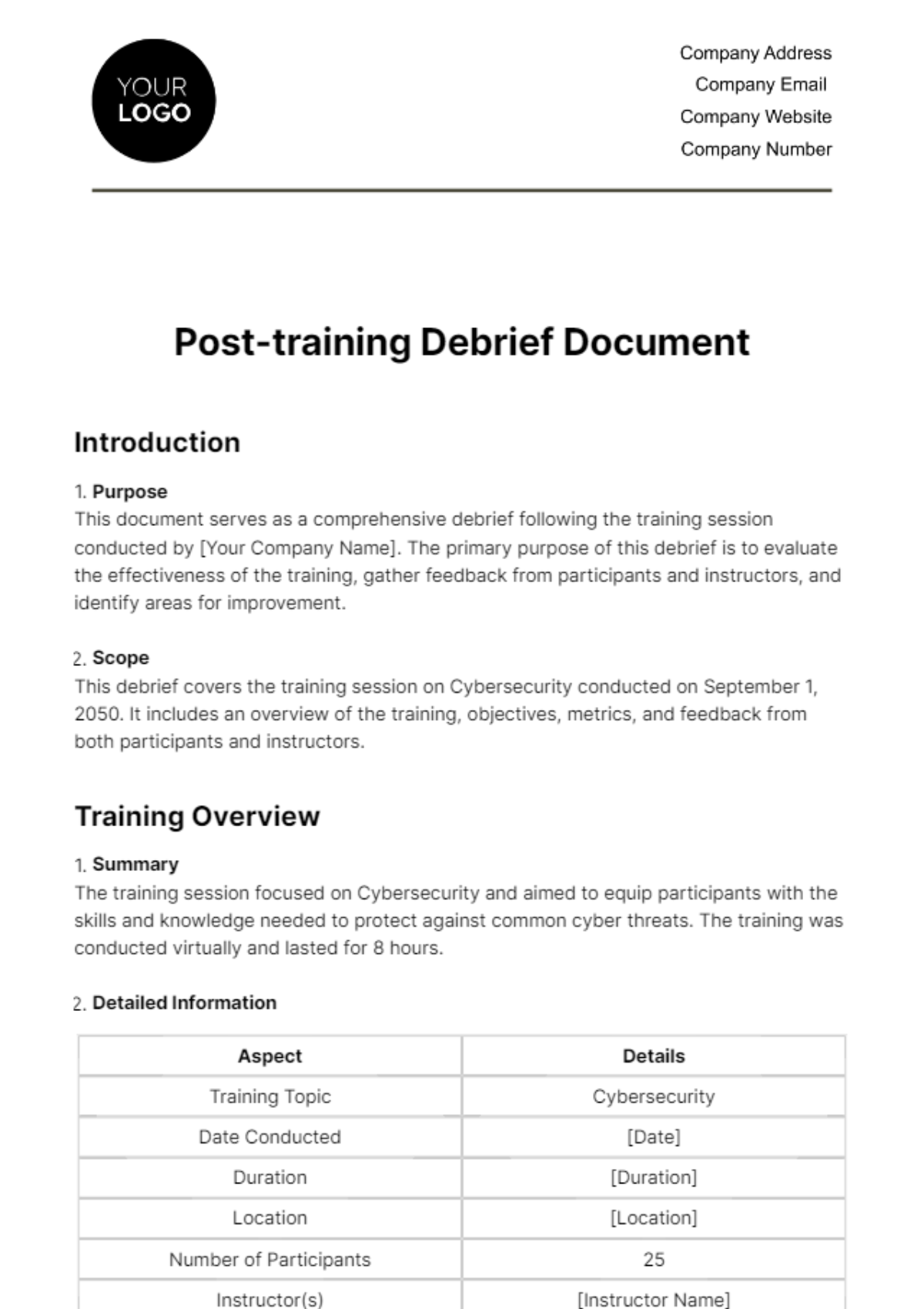Post-training Debrief Document
Introduction
Purpose
This document serves as a comprehensive debrief following the training session conducted by [Your Company Name]. The primary purpose of this debrief is to evaluate the effectiveness of the training, gather feedback from participants and instructors, and identify areas for improvement.
Scope
This debrief covers the training session on Cybersecurity conducted on September 1, 2050. It includes an overview of the training, objectives, metrics, and feedback from both participants and instructors.
Training Overview
Summary
The training session focused on Cybersecurity and aimed to equip participants with the skills and knowledge needed to protect against common cyber threats. The training was conducted virtually and lasted for 8 hours.
Detailed Information
Aspect | Details |
Training Topic | Cybersecurity |
Date Conducted | [Date] |
Duration | [Duration] |
Location | [Location] |
Number of Participants | 25 |
Instructor(s) | [Instructor Name] |
Training Materials Used
● PowerPoint Presentations
● Hands-on Exercises
● Case Studies
● Quizzes
Training Objectives
Objectives Defined
The training had three main objectives:
● Objective 1:
Understand the basics of cybersecurity, including key terms and concepts.
● Objective 2:
Learn how to protect against common cyber threats such as phishing, malware, and ransomware.
● Objective 3:
Implement cybersecurity measures in a corporate environment, including setting up firewalls and secure passwords.
Alignment with Company Goals
The training objectives were aligned with [Your Company Name]'s broader goals of enhancing security measures and ensuring that all employees are well-equipped to protect against cyber threats.
Training Metrics
Attendance Metrics |
Participant Name | Role | Attendance |
[Developer Name] | Developer | Present |
[Analyst Name] | Analyst | Present |
[Manager Name] | Manager | Absent |
Performance Metrics
Attendance Metrics |
Metric | Target | Actual | Variance |
Completion Rate | 90% | 92% | +2% |
Knowledge Retention | 80% | 85% | +5% |
Participant Engagement | 70% | 75% | +5% |
Metric Analysis
The training exceeded expectations in all key performance metrics. The completion rate was higher than the target, indicating that the training was engaging and held the participants' attention. Knowledge retention was also above the target, suggesting that the training material was effective in conveying the intended information.
Participant Feedback
Summary of Feedback
1. Positive Feedback:
Participants found the hands-on exercises particularly useful and felt that the training was well-structured. |
2. Negative Feedback:
Some participants felt the training could have been more interactive and suggested including more real-world examples. |
3. Detailed Feedback
Participant Name | Feedback |
[Developer Name] | The training was very informative. |
[Analyst Name] | I wish there were more real-world examples. |
[Manager Name] | I was unable to attend due to a scheduling conflict. |
4. Feedback Analysis
The feedback received was largely positive, with participants praising the structure and content of the training. However, there were suggestions for making the training more interactive, which will be considered for future sessions.
Instructor Feedback
Instructor Observations
1. Strengths:
The training materials were well-prepared, and participants were highly engaged during the hands-on exercises. |
2. Areas for Improvement:
More time could be allocated for Q&A sessions to address participant queries effectively. |
3. Instructor Recommendations:
The instructor recommended updating the training materials to include more real-world examples and also suggested conducting a dry run before the actual training to ensure smooth execution. |
Key Takeaways
Summary of Key Insights
● Takeaway 1:
Participants gained a strong foundational understanding of cybersecurity, exceeding the initial objectives.
● Takeaway 2:
Hands-on exercises were highly effective in reinforcing learning.
● Takeaway 3:
Scheduling conflicts can impact attendance and should be considered for future training.
● Implications for Future Trainings:
The key takeaways suggest that the training was largely successful but also highlight areas where improvements can be made, such as scheduling and interactivity.
Recommendations
Suggestions for Improvement
● Recommendation 1:
Include more real-world examples in the training material to enhance practical understanding.
● Recommendation 2:
Allocate more time for Q&A sessions to ensure that all participant queries are addressed.
● Recommendation 3:
Conduct a pre-training survey to avoid scheduling conflicts and better align with participant availability.
Next Steps
Action Plan
● Next Step 1:
Update the training material based on feedback received, incorporating more real-world examples and interactive elements.
● Next Step 2:
Plan the next training session, taking into consideration the recommendations and key takeaways from this debrief.
● Next Step 3:
Conduct a follow-up survey to measure knowledge retention and the long-term impact of the training.
Document Approved By:
[Approver's Name]
[Approver's Role]
[Your Company Name]
[Your Company Address]
[Your Company Number]
[Your Company Email]
[Your Company Website]
[Your Company social media]
© [Your Company Name], 2050. All rights reserved.
HR Templates @ Template.net






























